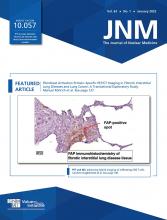TO THE EDITOR: We have read with great interest the article “Prognostic Value of Bone Marrow Metabolism on Pretreatment 18F-FDG PET/CT in Patients with Metastatic Melanoma Treated with anti-PD-1 Therapy” from Nakamoto et al. (1). Although The Journal of Nuclear Medicine has published several papers highlighting the clinical value of sequential 18F-FDG PET/CT for response assessment (2,3), this new article showed that baseline 18F-FDG PET/CT could also be used to guide treatment decisions.
To this end, the authors studied a population of 92 patients with a diagnosis of metastatic melanoma treated with immune checkpoint inhibitors (ICIs) (1). ICIs included anti-PD1 as single-agent (88%) or in combination (12%) with anticytotoxic T-lymphocyte antigen-4 or antilymphocyte activation gene-3. The authors have evaluated whether patients’ overall survival (OS) could be predicted by biomarkers such as demographic or clinical (n = 4), biologic (n = 1), pathologic (n = 1), and imaging variables extracted from baseline and on treatment 18F-FDG PET/CT (n = 6).
Confirming Prognostic Significance of BM Metabolism
In this population, the authors confirmed that noninvasive measurement of glucose metabolism on nontumoral bone marrow can be used to predict OS in patients with a diagnosis of advanced melanoma treated with ICIs (4). They demonstrated that mean bone marrow–to–liver uptake ratio (BLRmean = bone marrow SUVmean/liver SUVmean) was the most valuable prognostic imaging biomarker. High baseline BLRmean predicted a significantly poor progression-free survival and OS. The finding that bone marrow glucose metabolism is an imaging biomarker correlated with survival is of interest and aligns with findings in existing literature (4,5). Hence, this letter aims to share with the readership of The Journal of Nuclear Medicine (JNM) recent publications in the field to provide a deeper understanding on the relationship between bone marrow and clinical outcomes.
Association Between Bone Marrow (BM) Metabolism and Systemic Inflammation
In a recent review published in JNM, tumor and bone marrow glucose metabolism were analyzed in 12 studies including 2,588 cancer patients who underwent both 18F-FDG PET/CT scans and biochemical assessments with blood samples (6). Most studies showed that these imaging biomarkers were associated with clinical outcomes as well as systemic inflammatory responses (high C-reactive protein, low albumin, high neutrophils or leukocytes or platelets).
Association Between Bone Marrow (BM) Metabolism and Tumor Immune Environment
Because there is a cross talk between the tumor immune environment and BM, our team evaluated the association between bone marrow glucose metabolism and transcriptomics in patients with a diagnosis of metastatic cutaneous melanoma treated with ICIs (4). To this end, we assessed the tumor immune microenvironment using transcriptomics analysis on tumor tissues. Strikingly, high bone marrow metabolism was associated with an upregulation of genes related to dendritic cells, regulatory T cell activity, and memory T cells phenotypes (4).
Of note, this was a pilot study and the major molecular pathways determining the cross talk between the BM and tumor immune environment remain to be elucidated. For now, preclinical studies showed that tumor growth in melanoma seems to play a critical role in reprogramming the host immune system by regulating hematopoiesis, which might be associated with the expansion of immunosuppressive cells such as tumor-associated macrophages, regulatory T cells, and myeloid-derived suppressor cells (MDSCs) (7).
In patients with gynecologic cancer, high BM glucose metabolism was mainly due to the production of granulocyte colony-stimulating factor (G-CSF) by tumor cells (8). Patients with high BM glucose metabolism displayed an immunosuppressive phenotype with increased MDSCs and decreased CD8+ T cells (8).
Prospective studies and translational studies correlating BM glucose metabolism with antitumor immunity are warranted. Continued efforts need to be made and should focus on improving our understanding of physiopathologic concepts. We have to clarify the association between baseline bone marrow glucose metabolism and the presence of an immunosuppressive environment. This is necessary to unravel further cancer-related inflammation and immunosuppressive phenotypes associated with immunotherapy resistance through the use of quantitative transcriptome analyses of tumor, lymphoid tissue biopsies, and immuno-PET imaging.
Potential Theranostic Approaches
The demonstration of the prognostic value of BM glucose metabolism and of its association with tumor immune environment offers a springboard to exciting, new theranostic research. Novel therapies blocking immunosuppressive agents, such as MDSCs, are indeed under investigation (9) to potentiate ICIs. The underlying assumption is that glucose metabolism on tissues with medullary and extramedullary hematopoiesis could be associated with tumor-induced immune suppression. For instance, preimmunotherapy 18F-FDG PET/CT that explores bone marrow might be a relevant assay to predict response to MDSCs-blockade therapies, in combination with ICI (10).
In conclusion, the scientific community has demonstrated that BM glucose metabolism measured on 18F-FDG PET is associated with immunotherapy outcomes in patients with metastatic melanoma. The next step is to pursue efforts with prospective and large multicenter studies that would ensure a deeper understanding on how this specific biomarker could be used as a clinical decision support tool in patients with metastatic melanoma treated with ICIs.
DISCLOSURE
No potential conflict of interest relevant to this article was reported.
- © 2022 by the Society of Nuclear Medicine and Molecular Imaging.







